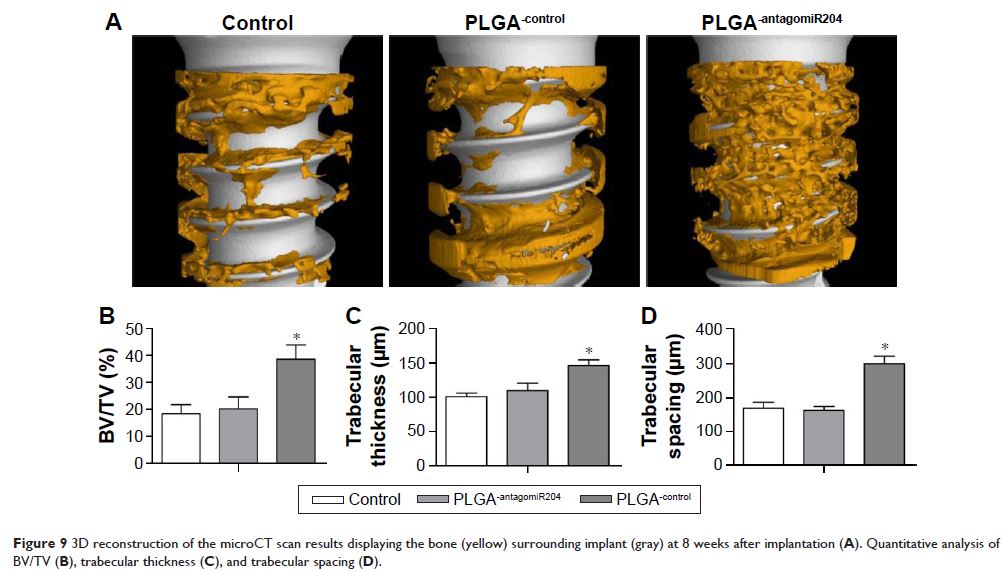9 0 9 6 8
论文已发表
注册即可获取德孚的最新动态
IF 收录期刊
- 2.6 Breast Cancer (Dove Med Press)
- 3.9 Clin Epidemiol
- 3.3 Cancer Manag Res
- 3.9 Infect Drug Resist
- 3.6 Clin Interv Aging
- 4.8 Drug Des Dev Ther
- 2.8 Int J Chronic Obstr
- 8.0 Int J Nanomed
- 2.3 Int J Women's Health
- 3.2 Neuropsych Dis Treat
- 4.0 OncoTargets Ther
- 2.2 Patient Prefer Adher
- 2.8 Ther Clin Risk Manag
- 2.7 J Pain Res
- 3.3 Diabet Metab Synd Ob
- 4.3 Psychol Res Behav Ma
- 3.4 Nat Sci Sleep
- 1.9 Pharmgenomics Pers Med
- 3.5 Risk Manag Healthc Policy
- 4.5 J Inflamm Res
- 2.3 Int J Gen Med
- 4.1 J Hepatocell Carcinoma
- 3.2 J Asthma Allergy
- 2.3 Clin Cosmet Investig Dermatol
- 3.3 J Multidiscip Healthc

PLGA 片层释放递送 antagomiR204 共轭金纳米颗粒及其对促进 2 型糖尿病中钛植入物骨整合的意义
Authors Liu X, Tan N, Zhou Y, Wei H, Ren S, Yu F, Chen H, Jia C, Yang G, Song Y
Received 13 October 2016
Accepted for publication 1 December 2016
Published 26 September 2017 Volume 2017:12 Pages 7089—7101
DOI https://doi.org/10.2147/IJN.S124584
Checked for plagiarism Yes
Review by Single-blind
Peer reviewers approved by Dr Akshita Wason
Peer reviewer comments 2
Editor who approved publication: Dr Lei Yang
Abstract: Impaired
osseointegration of the implant remains the big hurdle for dental implant
therapy in diabetic patients. In this study, the authors first identified that
miR204 was strikingly highly expressed in the bone mesenchymal stem cells
(BMSCs) of diabetic rats. Forced expression of miR204 repressed the osteogenic
potential of BMSCs, while inhibition of miR204 significantly increased the
osteogenic capacity. Moreover, the miR204 inhibitor was conjugated with gold
nanoparticles (AuNP-antagomiR204) and dispersed them in the
poly(lactic-co-glycolic acid) (PLGA) solution. The AuNP-antagomiR204 containing
PLGA solution was applied for coating the surface of titanium implant. Electron
microscope revealed that an ultrathin sheet was formed on the surface of the
implant, and the AuNPs were evenly dispersed in the coated PLGA sheet. Cellular
experiments revealed that these encapsulated AuNP-antagomiR204 were able to be
released from the PLGA sheet and uptaken by adherent BMSCs. In vivo animal
study further confirmed that the AuNP-antagomiR204 released from PLGA sheet
promoted osseointegration, as revealed by microcomputerized tomography (microCT)
reconstruction and histological assay. Taken together, this study established
that miR204 misexpression accounted for the deficient osseointegation in
diabetes mellitus, while PLGA sheets aided the release of AuNP-antagomiR204,
which would be a promising strategy for titanium implant surface
functionalization toward better osseointegration.
Keywords: osseointegration, miR204, PLGA sheets, gold nanoparticles,
diabetes mellitus, titanium implant
